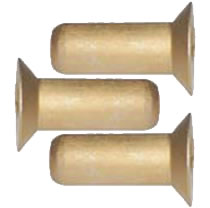
Airplanes contain many different fasteners. A typical Boeing 747, in fact, has over 3 million fasteners on average. While some of them are temporary fasteners that can be removed, others are permanent fasteners. Airplanes are often designed with hollow or solid rivets, which help to hold their respective parts together.
The Basics of Rivets
Rivets are permanent mechanical fasteners. Like all fasteners, they are used to hold parts together. Most rivets have a cylindrical body and a smooth, rounded head. Driving a rivet through two or more parts will hold the parts together. As the rivet enters the parts, the tail will expand.
There are no threads on rivets. Threaded fasteners are classified as temporary fasteners. After installing a threaded fastener, you can remove it. Rivets are classified as permanent fasteners. You can’t easily remove them because they don’t have threads.
Hollow vs Solid Rivets
Some rivets are hollow, whereas others are solid. Hollow and solid rivets feature a similar design. They both have a cylindrical body, and they both have a smooth and rounded head. The difference, of course, is that hollow rivets consist of a shell with an empty interior. Solid rivets, on the other hand, are completely solid.
Pros and Cons of Using Solid Rivets
Solid rivets are commonly used in aerospace manufacturing applications. They offer a simple and effective way to fasten two or more parts. You can use solid rivets to secure multiple parts together.
You don’t have to worry about the parts loosening due to vibrations. Airplanes produce vibrations during flight. While vibrations may cause temporary fasteners to separate from parts, this isn’t a concern for permanent fasteners like rivets.
Solid rivets eliminate the need for nuts and washers. If you use bolts to secure multiple parts, you may have to affix them with a nut and washer. Solid rivets don’t require a nut and washer because they are permanent.
You’ll need access to both sides of the parts when using solid rivets. If you only have access to the front or back of the parts, you may want to choose a different type of fastener. There are blind fasteners, such as blind rivets, that only require access to a single side. But solid rivets require access to both sides.
You’ll also need a special tool to install solid rivets. Known as a rivet compression tool, it will force solid rivets to expand when placed inside of parts.



